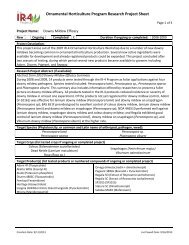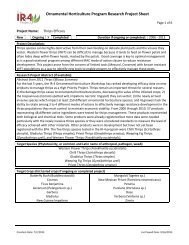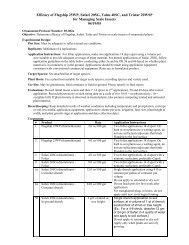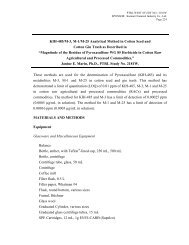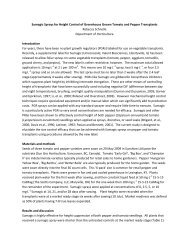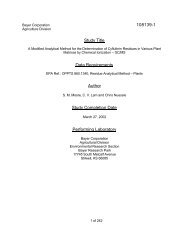Bayer CropScience AG Page 1 of 82 BCS-RD-D ... - IR-4 Project
Bayer CropScience AG Page 1 of 82 BCS-RD-D ... - IR-4 Project
Bayer CropScience AG Page 1 of 82 BCS-RD-D ... - IR-4 Project
You also want an ePaper? Increase the reach of your titles
YUMPU automatically turns print PDFs into web optimized ePapers that Google loves.
<strong>Bayer</strong> <strong>CropScience</strong> <strong>AG</strong> <strong>Page</strong> 9 <strong>of</strong> <strong>82</strong><br />
<strong>BCS</strong>-<strong>RD</strong>-D-ROCS Method-No. 00857<br />
D-40789 Monheim Report No. MR-099/04<br />
1 Summary<br />
The analytical method 00857 presented in this report was developed in order to<br />
determine residues <strong>of</strong> BYI08330 (parent compound, total residue <strong>of</strong> BYI08330) and its<br />
metabolites BYI08330-enol, BYI08330-ketohydroxy, BYI08330-mono-hydroxy and<br />
BYI08330-enol-Glc in/on plant material by HPLC-ESI-MS/MS using stable isotopically<br />
labelled internal standards.<br />
BYI08330 and its metabolites BYI08330-enol, BYI08330-ketohydroxy, BYI08330-monohydroxy<br />
and BYI08330-enol-Glc are extracted from the sample material using a blender<br />
with an acidic acetonitrile/water mixture (4/1, v/v). After filtration <strong>of</strong> the extract, the<br />
corresponding stable isotopically labelled analytes are added. Afterwards, the solution is<br />
made up to volume, diluted and subjected to HPLC-MS/MS without any further clean-up<br />
step (with exception <strong>of</strong> hop where a second filtration step was used).<br />
For quantification external calibration with standard solutions quoting the peak area ratio<br />
<strong>of</strong> the analytes and the corresponding stable isotopically labelled internal standards<br />
were used. If matrix problems are observed, HPLC-MS/MS conditions have to be<br />
adapted.<br />
The limit <strong>of</strong> quantitation (LOQ) is 0.01 mg/kg for each single compound corresponding<br />
to the lowest fortification level <strong>of</strong> successfully conducted recovery experiments with<br />
exception <strong>of</strong> hop cone with a LOQ <strong>of</strong> 0.10 mg/kg. The limit <strong>of</strong> detection (LOD) for all<br />
single compounds was estimated to be at about 4 times lower than the corresponding<br />
LOQ, as could be concluded from the linearity data and matrix interference in untreated<br />
control samples. For determination <strong>of</strong> the total residue <strong>of</strong> BYI08330 (sum <strong>of</strong> single<br />
analyte residues each calculated as BYI08330 equivalents), the LOQ is calculated as<br />
0.055 mg/kg for all matrices with exception <strong>of</strong> hop cone (0.55 mg/kg).<br />
A linear correlation between the injected amount <strong>of</strong> the analytes and the detector<br />
response was observed for standards in solvent (5 ng/L to 50 µg/L) using stable<br />
isotopically labelled internal standards. The correlation coefficients <strong>of</strong> the 1/x weighted<br />
linear regression were 0.9976 to 0.9995.<br />
The occurrence <strong>of</strong> matrix effects was not monitored during method development and<br />
validation, as the internal standard procedure using stable isotopically labelled internal<br />
standards compensates for matrix effects. If matrix interferences or matrix effects are<br />
observed, the HPLC-MS/MS conditions have to be adapted.<br />
The stability <strong>of</strong> BYI08330 and its metabolites BYI08330-enol, BYI08330-ketohydroxy,<br />
BYI08330-mono-hydroxy and BYI08330-enol-Glc in stock and standard solutions<br />
(water/acetonitrile, 2/8, v/v + 0.22 mL/L formic acid) was tested.<br />
The results indicate that all analytes are stable in standard solutions for at least four<br />
weeks <strong>of</strong> storage in a refrigerator at 4°C ± 3°C under dark conditions.<br />
Blank values in untreated control samples were well below 30% <strong>of</strong> the LOQ.



